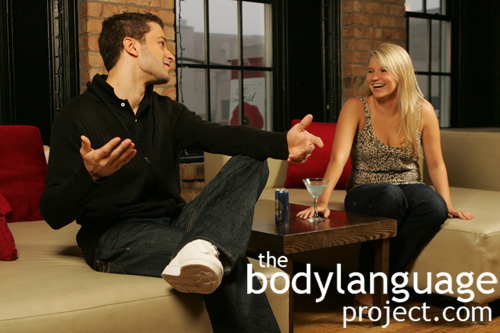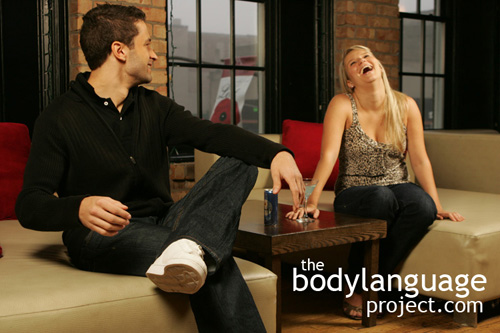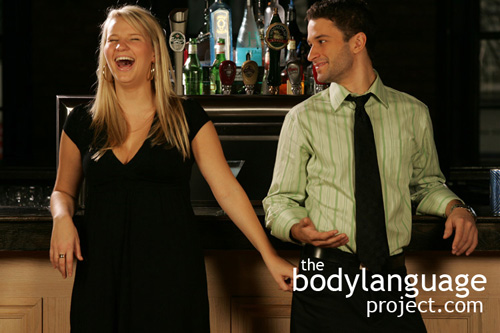Body Language of Hand Over The Chest
 Cue: Hand Over The Chest
Cue: Hand Over The Chest
Synonym(s): Hand On The Heart.
Description: When the hand is clasped over the chest or heart.
In One Sentence: Holding the hand over the heart is signal that one is thinking about the best interest of others.
How To Use it: Research has shown that when people hold their hands to their hearts they are primed to make better moral judgments. When you wish to have others make an honest confession, having them swear and make oath by holding their hands over their chest, will help produce desired results.
Likewise, when you wish to show others that you are thinking about them and hold a caring attitude for them, hold your hand over your heart to pledge your moral position.
Context: General.
Verbal Translation: “My heart is warm and I’m thinking about you and have your best interest at heart so I’m clasping the soul of my body, my heart because I want you to really see how important you are to me.”
Variant: One or two hands might come up. When two hands come up it appears as a self hug and rocking from side to side might accompany. This shows tender love and a desire to feel comforted and secure.
Cue In Action: We might see the hand of a salesman come to his chest to show his deepest desire to sell you a valued product.
Meaning and/or Motivation: An appeal to honesty and sincerity or deep appreciation. When we show our condolences to a family member for their lose, we will bring our hand to our heart. Our hand comes to our heart when we wish to be believed and show that it is us who cares deeply about another.
Cue Cluster: Hand over the heart is usually accompanied by a titled head, wide smile, and kind eyes.
Body Language Category: Emotional body language, Honest body language, Liking, Nonthreatening body language, Rapport or rapport building.
Resources:
Andric, Michael ; Solodkin, Ana ; Buccino, Giovanni ; Goldin-Meadow, Susan ; Rizzolatti, Giacomo ; Small, Steven L. Brain function overlaps when people observe emblems, speech, and grasping. Neuropsychologia, 2013, Vol.51(8), pp.1619-1629
Alibali, M.W., Heath, D.C., and Myers,H.J. (2001). Effects of visibility between speaker and listener on gesture production: Some gestures are meant to be seen. Journal of Memory and Language, 44, 169–188.
Beattie, G., & Shovelton,H.(1999). Mapping the range of information contained in the iconich and gestures that accompany spontaneous speech. Journal of Language and social Psychology, 18, 438–462.
Biau, E., & Soto-Faraco, S.(2013). Beat gestures modulate auditory integration in speech perception. Brain and Language, 124(2), 143–152.
Bartolo, A.,Cubelli,R.,DellaSala,S.,&Drei,S.(2003).Pantomimes are special gestures which rely on working memory. Brain and Cognition, 53, 483–494.
Bernardis, P.,& Gentilucci,M.(2006).Speech hand gestures are the same communication system. Neuropsychologia, 44, 178–190.
Buccino, G.,Vogt,S., Ritzl, A., Fink, G .R., Zilles, K., Freund, H. J., et al.(2004).Neural circuits underlying imitation learning of hand actions: Anevent-related fMRI study. Neuron, 42, 323–334.
Chandler, Jesse ; Schwarz, Norbert. How extending your middle finger affects your perception of others: Learned movements influence concept accessibility. Journal of Experimental Social Psychology. 2009. 45(1): 123-128.
http://bodylanguageproject.com/articles/how-extending-the-middle-finger-affects-perception/
Dick, A.S., Goldin-Meadow,S., Hasson,U.,Skipper, J.I., & Small, S.L. (2009). Co- speech gestures influence neural activity in brain regions associated with processing semantic information. Human Brain Mapping, 30, 3509–3526.
Fabbri-Destro, M.,& Rizzolatti,G. (2008). Mirror neurons and mirror systems in monkeys and humans. Physiology, 23, 171–179.
Fogassi, L., Gallese,V., Fadiga,L., & Rizzolatti,G. (1998). Neurons responding to the sight of goal directed hand/armactions in the parietal area PF (7b) of the macaque monkey. Society for Neuroscience, 24, 257.5.
Fusaro, M., Harris, P. L., & Pan, B. A. (2012). Head nodding and head shaking gestures in children’s early communication. First Language, 32, 439–458. doi:10.1177/0142723711419326
Gentilucci, M., Bernardis, P., Crisi,G., & Dalla Volta, R. (2006). Repetitive transcranial magnetic stimulation of Broca’s area affects verbal responses to gesture observation. Journal of Cognitive Neuroscience, 18, 1059–1074.
Goldin-Meadow, S. (1999).The role of gesture in communication and thinking. Trends in Cognitive Sciences, 3, 419–429.
Goldin-Meadow, S.(2003). Hearing gesture: How our hands help us think. Cam-bridge, MA: Belknap Press of Harvard University Press.
Gräfenhain, M., Behne, T., Carpenter, M., & Tomasello, M. (2009). One-year-olds’ understanding of nonverbal gestures directed to a third person. Cognitive Development, 24, 23–33. doi:10.1016/j.cogdev.2008.10.001
Guidetti, M. (2005). Yes or no? How do young children combine gestures and words to agree and refuse. Journal of Child Language, 32, 911–924. doi:10.1017/S0305000905007038
Hummer, P., Wimmer, H., & Antes, G. (1993). On the origins of denial negation. Journal of Child Language, 20, 607– 618. doi:10.1017/S0305000900008503
Hubbard, A.L., Wilson,S.M., Callan,D.E., & Dapretto, M.(2009). Giving speech a hand: Gesture modulates activity in auditory cortex during speech perception. Human Brain Mapping, 30, 1028–1037.
He, Yifei ; Gebhardt, Helge ; Steines, Miriam ; Sammer, Gebhard ; Kircher, Tilo ; Nagels, Arne ; Straube, Benjamin. The EEG and fMRI signatures of neural integration: An investigation of meaningful gestures and corresponding speech. Neuropsychologia. 2015. 72: 27-42.
Hansen, Jacqueline. Teaching without talking: teachers need to be aware of more than just the words they speak to children. They also need to monitor the nonverbal messages that they’re sending to students through proximity, eye contact, gestures, and touching. Phi Delta Kappan. 2010. 92(1): 35(6).
Holle, H., & Gunter,T.C. (2007). The role of iconic gestures in speech disambiguation: ERP evidence. Journal of Cognitive Neuroscience, 19, 1175–1192.
Holler, J., Shovelton, H.,& Beattie, G.(2009).Do iconic hand gestures really contribute to the communication of semantic information in a face-to-face context? Journal of Nonverbal Behavior, 33, 73–88.
Hubbard, A.L., Wilson, S. M., Callan, D. E., & Dapretto, M.(2009).Giving speech a hand: Gesture modulates activity in auditory cortex during speech perception. Human Brain Mapping, 30, 1028–1037.
Kendon,A.(1994).Do gestures communicate? A review. Research on Language and Social Interaction, 27, 175–200.
Knutson, K.M., McClellan,E.M., & Grafman, J.(2008).Observing social gestures: An fMRI study. Experimental Brain Research, 188, 187–198.
Kelly, S. D., Barr, D. J., Church, R. B., & Lynch, K.(1999).Offering a hand topragmatic understanding: The role of speech and gesture in comprehension and memory. Journal of Memory and Language, 40, 577–592.
Kelly, S. D., Creigh, P., & Bartolotti, J.(2009).Integrating speech and iconic gestures in a Stroop-like task: Evidence for automatic processing. Journal of Cognitive Neuroscience, 22, 683–694.
Kelly, S.D., Kravitz, C.,& Hopkins, M.(2004).Neural correlates of bimodal speech and gesture comprehension. Brain and Language, 89(1), 253–260.
Krahmer,E., & Swerts, M.(2007).The effects of visual beats on prosodic prominence: Acoustic analyses, auditory perception and visual perception. Journal of Memory and Language, 57, 396–414.
Krauss, R. M., Dushay, R.A., Chen,Y., & Rauscher, F.(1995).The communicative value of conversational hand gesture. Journal of Experimental Social Psychology, 31(6), 533–552.
Leonard, T., & Cummins, F.(2010).The temporal relation between beat gestures and speech. Language and Cognitive Processes, 26, 1457–1471.
Lindenberg, R., Uhlig,M., Scherfeld,D., Schlaug,G., & Seitz, R.J.(2012).Commu- nication with emblematic gestures: Shared and distinct neural correlates of expression and reception. Human Brain Mapping, 33, 812–823.
Mussweiler, T. (2006). Doing is for thinking! Stereotype activation by stereotypic movements. Psychological Science, 17, 17–21. doi:10.1111/j.1467-9280.2005.01659.x.
Michal Parzuchowski and Bogdan Wojciszke. Hand Over Heart Primes Moral Judgments and Behavior. Journal of Nonverbal Behavior, 2014; 38:145–165.
http://bodylanguageproject.com/articles/hand-over-heart-primes-moral-judgments-and-behavior/
Montgomery, K.J., Isenberg, N., & Haxby,J.V. (2007). Communicative hand gestures and object-directed hand movements activated the mirror neuron system. Social Cognitive and Affective Neuroscience, 2, 114–122.
Molnar-Szakacs, Istvan ; Wu, Allan D ; Robles, Francisco J ; Iacoboni, Marco Robertson, Edwin (Academic Editor). Do You See What I Mean? Corticospinal Excitability During Observation of Culture-Specific Gestures (Gesture Perception). PLoS ONE. 2007. 2(7): p.e626
Niedenthal, P. M., Barsalou, L., Winkielman, P., Krauth-Gruber, S., & Ric, F. (2005). Embodiment in attitudes, social perception, and emotion. Personality and Social Psychology Review, 9, 184–211. doi:10.1207/s15327957pspr0903_1.
Ohgami, Y., Matsuo,K., Uchida,N., & Nakai,T. (2004). An fMRI study of tool-use gestures: Body partas object and pantomime. Neuroreport, 15, 1903–1906.
Riskind, J. H. (1983). Nonverbal expressions and the accessibility of life experience memories: A congruence hypothesis. Social Cognition, 2, 62–86. doi:10.1521/soco.1983.2.1.62.
Schnall, S., Haidt, J., Clore, G. L., & Jordan, A. H. (2008). Disgust as embodied moral judgment. Personality and Social Psychology Bulletin, 34, 1096–1109. doi:10.1177/0146167208317771.
Schubert, Thomas W. The Power In Your Hand: Gender Differences In Bodily Feedback
From Making a Fist. Society for Personality and Social Psychology. 2004. 30(6): 757-769. DOI: 10.1177/0146167204263780
http://bodylanguageproject.com/articles/men-view-power-body-language-different-women-bodily-feedback-making-fist/
Strack, F., Martin, L. L., & Stepper, S. (1988). Inhibiting and facilitating condition of facial expressions: A non-obtrusive test of the facial feedback hypothesis. Journal of Personality and Social Psychology, 54, 768–777. doi:10.1037//0022-3514.54.5.768.
Skipper, J.I., Goldin-Meadow, S., Nusbaum,H.C.,& Small,S.L. (2007).Speech- associated gestures, Broca’s area, and the human mirror system. Brain and Language, 101, 260–277.
Sherzer, Joel The Brazilian Thumbs-Up Gesture. Journal of Linguistic Anthropology, 1991, Vol.1(2), pp.189-197
Straube,B., Green,A., Bromberger,B., & Kircher, T. (2011).The differentiation of iconic and metaphoric gestures: Common and unique integration processes. Human Brain Mapping, 32, 520–533.
Straube, Benjamin ; Green, Antonia ; Jansen, Andreas ; Chatterjee, Anjan ; Kircher, Tilo. Social cues, mentalizing and the neural processing of speech accompanied by gestures. Neuropsychologia. 2010. 48(2): 382-393.
Tam, C. W., & Stokes, S. F. (2001). Form and function of negation in early developmental Cantonese. Journal of Child Language, 28, 373–391. doi:10.1017/S0305000901004688
Villarreal, M., Fridman,E.A., Amengual,A., Falasco,G., Gerscovich,E.R., Ulloa,E.R., et al. (2008). The neural substrate of gesture recognition. Neuropsychologia, 46, 2371–2382.
Vaidyanathan, R. (1991). Development of forms and functions of negation in the early. tages of language acquisition: A study in Tamil. Journal of Child Language, 18, 51–66. doi:10.1017/S0305000900013295
Willems, R.M., Ozyurek,A., & Hagoort,P.(2007).When language meets action:The neural integration of gesture and speech. CerebralCortex, 17, 2322–2333.
Wieser, Matthias J.; Tobias Flaisch and Paul Pauli. Raised Middle-Finger: Electrocortical Correlates of Social Conditioning with Nonverbal Affective Gestures. 2014. PLoS ONE 9(7): e102937. doi:10.1371/journal.pone.0102937
http://bodylanguageproject.com/articles/powerful-nonverbal-effect-raised-middle-finger-persistent-brain-consequences-pairing/
Wu, Y. C., & Coulson, S.(2005).Meaningful gestures: Electrophysiological indices of iconic gesture comprehension. Psychophysiology, 42, 654–667.
Wang, Lin ; Chu, Mingyuan Neuropsychologia. The role of beat gesture and pitch accent in semantic processing: An ERP study. 2013, Vol.51(13), pp.2847-2855
Xu,J., Gannon,P.J., Emmorey,K., Smith,J.F., & Braun,A.(2009). Symbolic gestures and spoken language are processed by a common neural system. Proceedings of the NationalAcademyofSciences, 106, 20664–20669.
Zhong, C. B., & Liljenquist, K. (2006). Washing away your sins: Threatened morality and physical cleansing. Science, 313, 1451–1452. doi:10.1126/science.1130726.








